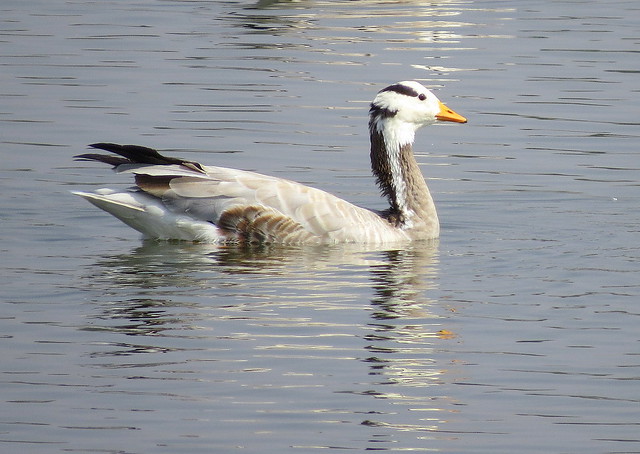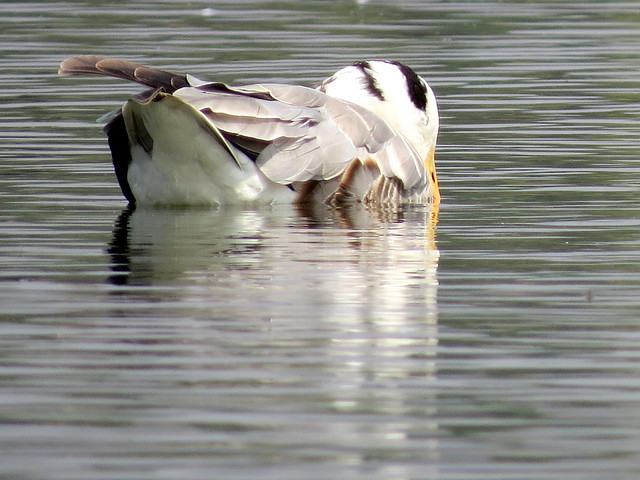Not Swan Lake, but Goose Lake. Hadinaru kere, 07 and 080215
February 10, 2015
I looked up the Wiki entry for the
(Anser indicus) is a goose that breeds in Central Asia in colonies of thousands near mountain lakes and winters in South Asia, as far south as peninsular India.
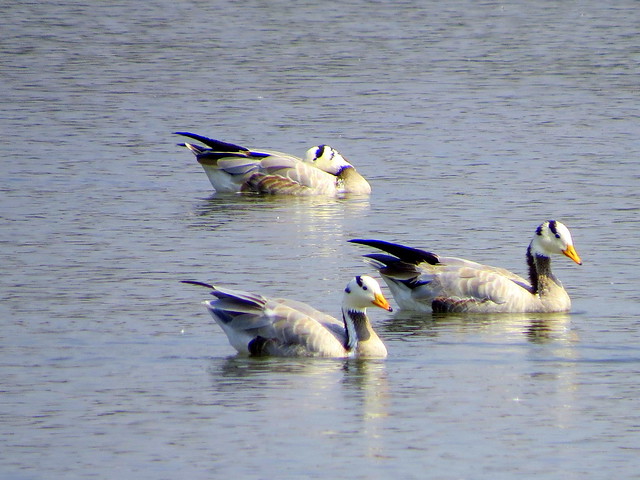 is quite an amazing instance of bird migration. The species has been reported as migrating south from Tibet, Kazakhstan, Mongolia and Russia before crossing the Himalaya.
is quite an amazing instance of bird migration. The species has been reported as migrating south from Tibet, Kazakhstan, Mongolia and Russia before crossing the Himalaya.
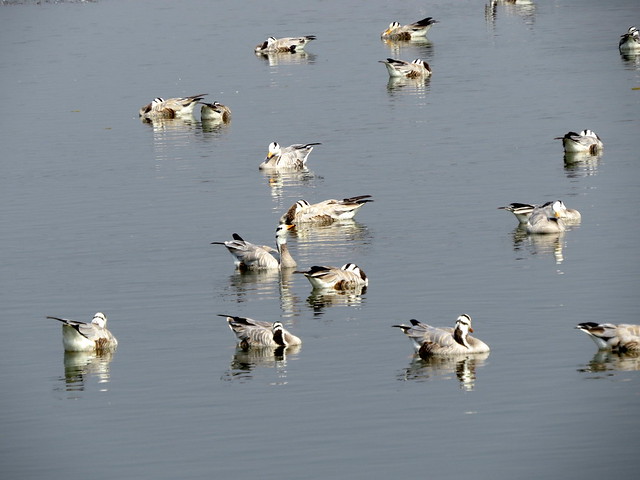 The species occurs over more than 2,500,000 sq km...just imagine that!
he bar-headed goose is one of the world's highest-flying birds,[2] having been heard flying across Mount Makalu – the fifth highest mountain on earth at 8,481 m (27,825 ft) – and apparently seen over Mount Everest – 8,848 m (29,029 ft) – although this is a second-hand report with no verification.
The species occurs over more than 2,500,000 sq km...just imagine that!
he bar-headed goose is one of the world's highest-flying birds,[2] having been heard flying across Mount Makalu – the fifth highest mountain on earth at 8,481 m (27,825 ft) – and apparently seen over Mount Everest – 8,848 m (29,029 ft) – although this is a second-hand report with no verification.
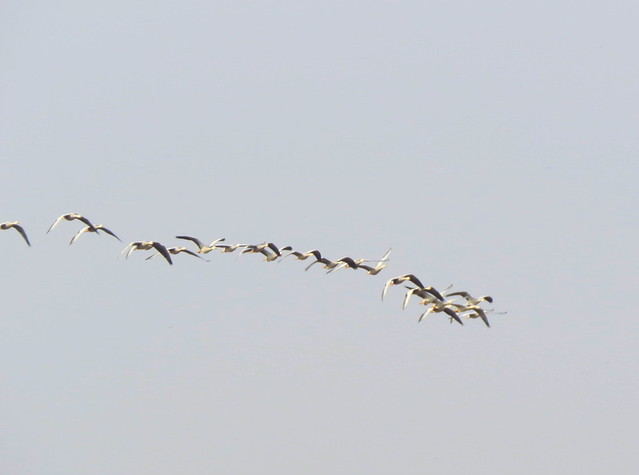

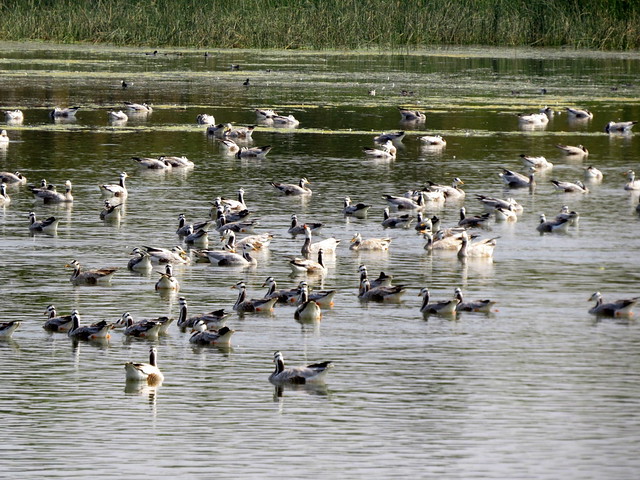 This demanding migration has long puzzled physiologists and naturalists: "there must be a good explanation for why the birds fly to the extreme altitudes... particularly since there are passes through the Himalaya at lower altitudes, and which are used by other migrating bird species."
This demanding migration has long puzzled physiologists and naturalists: "there must be a good explanation for why the birds fly to the extreme altitudes... particularly since there are passes through the Himalaya at lower altitudes, and which are used by other migrating bird species."
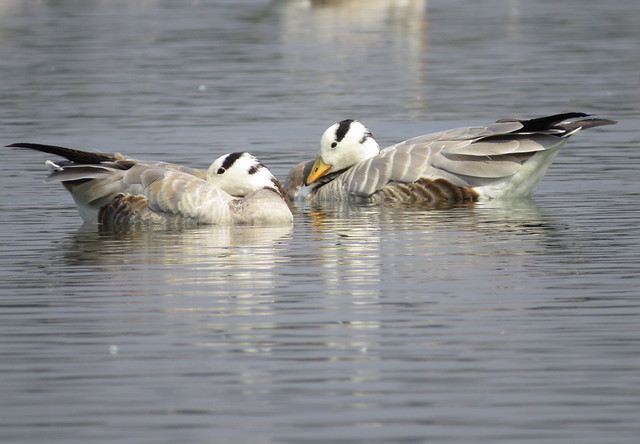 In fact, bar-headed geese have never been directly tracked (using GPS or satellite logging technology) flying higher than 6,540 metres (21,460 ft), and it is now believed that they do take the high passes through the mountains.
The challenging northward migration from lowland India to breed in the summer on the Tibetan Plateau is undertaken in stages, with the flight across the Himalaya (from sea-level) being undertaken non-stop in as little as seven hours.
Surprisingly, despite predictable tail winds that blow up the Himalayas (in the same direction of travel as the geese), bar-headed geese spurn these winds, waiting for them to die down overnight, when they then undertake the greatest rates of climbing flight ever recorded for a bird, and sustain these climb rates for hours on end, according to research published in 2011.
The 2011 study found the geese peaking at an altitude of around 6,400 m (21,000 ft).[2] In a 2012 study that tagged 91 geese
In fact, bar-headed geese have never been directly tracked (using GPS or satellite logging technology) flying higher than 6,540 metres (21,460 ft), and it is now believed that they do take the high passes through the mountains.
The challenging northward migration from lowland India to breed in the summer on the Tibetan Plateau is undertaken in stages, with the flight across the Himalaya (from sea-level) being undertaken non-stop in as little as seven hours.
Surprisingly, despite predictable tail winds that blow up the Himalayas (in the same direction of travel as the geese), bar-headed geese spurn these winds, waiting for them to die down overnight, when they then undertake the greatest rates of climbing flight ever recorded for a bird, and sustain these climb rates for hours on end, according to research published in 2011.
The 2011 study found the geese peaking at an altitude of around 6,400 m (21,000 ft).[2] In a 2012 study that tagged 91 geese
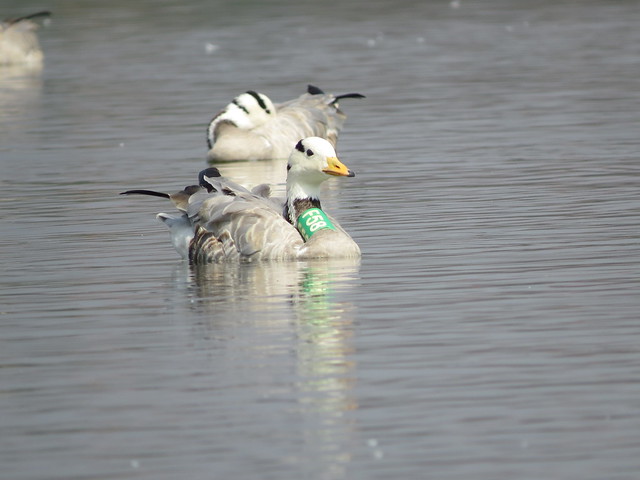 and tracked their migration routes, it was determined that the geese spent 95% of their time below 5,784 m (18,976 ft), choosing to take a longer route through the Himalayas in order to utilize lower-altitude valleys and passes.
and tracked their migration routes, it was determined that the geese spent 95% of their time below 5,784 m (18,976 ft), choosing to take a longer route through the Himalayas in order to utilize lower-altitude valleys and passes.
 Only 10 of the tagged geese were ever recorded above this altitude, and only one exceeded 6,500 m (21,300 ft), reaching 7,290 m (23,920 ft).
The bar-headed goose migrates over the Himalayas to spend the winter in parts of South Asia (from Assam to as far south as Tamil Nadu.
Only 10 of the tagged geese were ever recorded above this altitude, and only one exceeded 6,500 m (21,300 ft), reaching 7,290 m (23,920 ft).
The bar-headed goose migrates over the Himalayas to spend the winter in parts of South Asia (from Assam to as far south as Tamil Nadu.
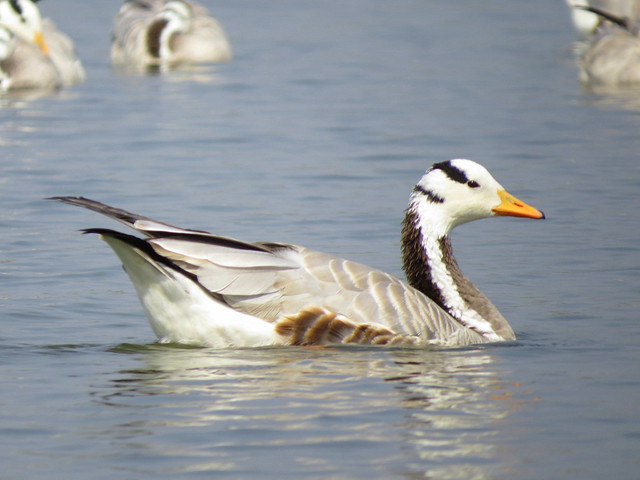 The modern winter habitat of the species is cultivated fields, where it feeds on barley, rice and wheat, and may damage crops. Birds from Kyrgyzstan have been noted to stopover in western Tibet and southern Tajikistan for 20 to 30 days before migrating further south. Some birds may show high wintering site fidelity.
The main physiological challenge of bar-headed geese is extracting oxygen from hypoxic air and transporting it to aerobic muscle fibres in order to sustain flight at high altitudes. Flight is very metabolically costly at high-altitudes because birds need to flap harder in thin air to generate lift.
The modern winter habitat of the species is cultivated fields, where it feeds on barley, rice and wheat, and may damage crops. Birds from Kyrgyzstan have been noted to stopover in western Tibet and southern Tajikistan for 20 to 30 days before migrating further south. Some birds may show high wintering site fidelity.
The main physiological challenge of bar-headed geese is extracting oxygen from hypoxic air and transporting it to aerobic muscle fibres in order to sustain flight at high altitudes. Flight is very metabolically costly at high-altitudes because birds need to flap harder in thin air to generate lift.
 Studies have found that bar-headed geese breathe more deeply and efficiently under low oxygen conditions
here
is an abstract about the trans-Himalayan flight of this bird.
Studies have found that bar-headed geese breathe more deeply and efficiently under low oxygen conditions
here
is an abstract about the trans-Himalayan flight of this bird.
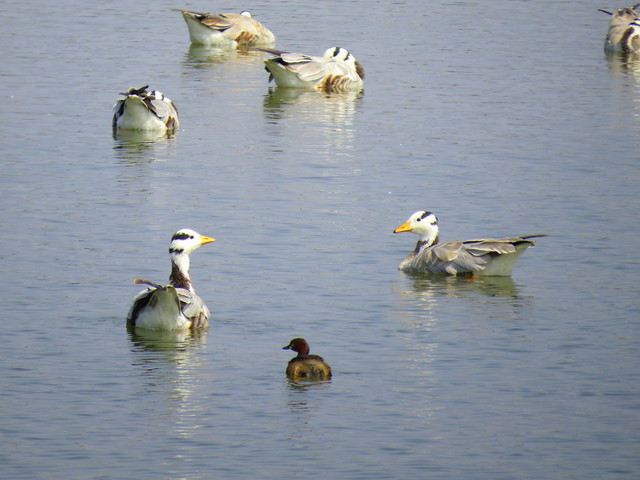 I was very curious about the diet of these birds that keep them going across their demanding flight, but most scientists seem more concerned about the aerodynamics of the bird's frame,
as in
this article in the Audubon Society .
I got one line in
this link
"Wild DietL Plants; also may eat crustaceans and invertebrates."
And this from the
St.Louis Zoo link :
"Bar-headed geese are mainly vegetarian. They feed primarily on grasses, roots, stems and other plant parts, as well as on grains, tubers and occasionally seaweed."
I was very curious about the diet of these birds that keep them going across their demanding flight, but most scientists seem more concerned about the aerodynamics of the bird's frame,
as in
this article in the Audubon Society .
I got one line in
this link
"Wild DietL Plants; also may eat crustaceans and invertebrates."
And this from the
St.Louis Zoo link :
"Bar-headed geese are mainly vegetarian. They feed primarily on grasses, roots, stems and other plant parts, as well as on grains, tubers and occasionally seaweed."
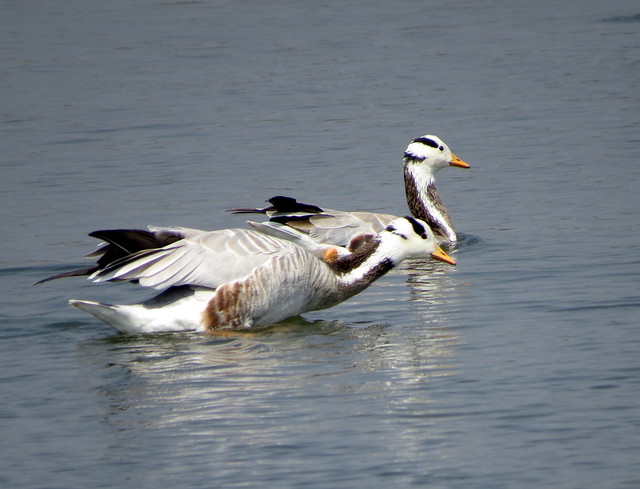 How does this diet keep them going on their high-altitude migration? I am still looking for answers (not Ansers!) .I am told that they do eat heavily before their departure
Regarding the bird identification from the tags, have written to
Tseveenmyadag Natsagdorj(tseveenmyadag@magicnet.mn) and Nyambayar Batbayar (info@wscc.org.mn)
who have tagged the geese in Mongolia. Their response about the tagging:
***************************
Dear Deepa Mohan,
Thank you very much for your information of color marked bar-headed geese in India. Here is the capture information of this birds.
This green color band A31
How does this diet keep them going on their high-altitude migration? I am still looking for answers (not Ansers!) .I am told that they do eat heavily before their departure
Regarding the bird identification from the tags, have written to
Tseveenmyadag Natsagdorj(tseveenmyadag@magicnet.mn) and Nyambayar Batbayar (info@wscc.org.mn)
who have tagged the geese in Mongolia. Their response about the tagging:
***************************
Dear Deepa Mohan,
Thank you very much for your information of color marked bar-headed geese in India. Here is the capture information of this birds.
This green color band A31
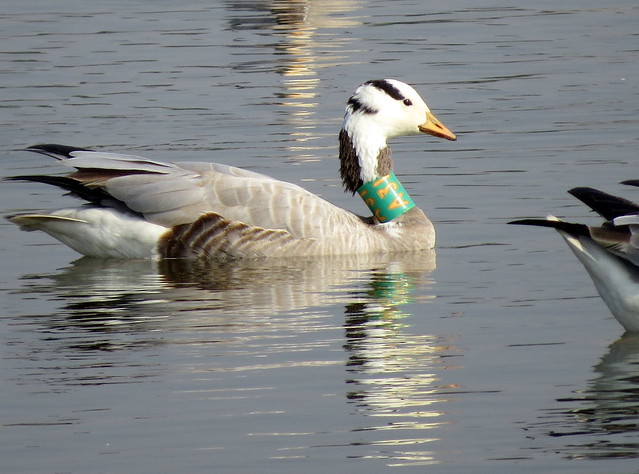 bird was captured and marked Nyambayar B. and Tseveenmyadag N. on 8 July 2009 at the Khokh lake near Terkhiin tsagaan lake in province Arkhangai of the Central Mongolia. Capture location is N48.170292, E99.561964. This birds was identified adult female, weighed 2050 g.
Next yellow color band D9
bird was captured and marked Nyambayar B. and Tseveenmyadag N. on 8 July 2009 at the Khokh lake near Terkhiin tsagaan lake in province Arkhangai of the Central Mongolia. Capture location is N48.170292, E99.561964. This birds was identified adult female, weighed 2050 g.
Next yellow color band D9
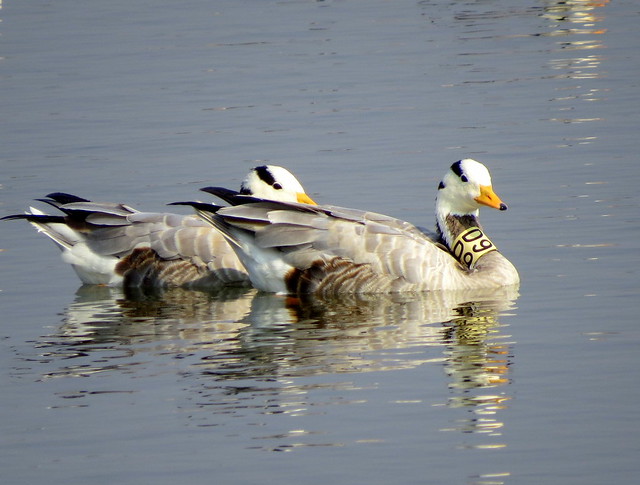 bird was captured and marked Martin Gilbert on 17 July 2008 at the Darkhad Valley in province Khovsgol of the Nortern Mongolia. Capture location is N51.19736, E99.41078. This birds was identified adult female, weighed 2150 g.
.
Neck collar ID:
F58
RF
Neck collar color:
green
orange
Age:
Sex:
Female
Weight:1950 g
Capture date:12 July 2014
16 July 2009
Capture location:
Khar lake near Terkhiin tsagaan lake in province Arkhangai of the Central Mongolia
Sharga lake in province Bulgan of the Central Mongolia
GPS coordinate:
48.148636N, 99.587912E
48.94365N, 101.97030E
Banders:
Nyambayr B, Tseveenmyadag N. et al
Martin Gilbert
Color coding indicates the year of tagging. Some of our birds are carrying data loggers and GPS location transmitters. Some of those radio marked birds do not have neck collars because we wanted to limit the weight of the birds. But a number of birds also do not have neck collars because they were too small to receive neck collars. We put green leg bands on those young geese. So those birds without neck collars might be either young or birds with transmitters.
Most of our birds also have metal rings in addition to color markers as part of the regular marking protocol.
Best,
N. Tseveenmyadag, PhD
Head of Ornithology Lab, Institute of Biology, MAS
*************************
bird was captured and marked Martin Gilbert on 17 July 2008 at the Darkhad Valley in province Khovsgol of the Nortern Mongolia. Capture location is N51.19736, E99.41078. This birds was identified adult female, weighed 2150 g.
.
Neck collar ID:
F58
RF
Neck collar color:
green
orange
Age:
Sex:
Female
Weight:1950 g
Capture date:12 July 2014
16 July 2009
Capture location:
Khar lake near Terkhiin tsagaan lake in province Arkhangai of the Central Mongolia
Sharga lake in province Bulgan of the Central Mongolia
GPS coordinate:
48.148636N, 99.587912E
48.94365N, 101.97030E
Banders:
Nyambayr B, Tseveenmyadag N. et al
Martin Gilbert
Color coding indicates the year of tagging. Some of our birds are carrying data loggers and GPS location transmitters. Some of those radio marked birds do not have neck collars because we wanted to limit the weight of the birds. But a number of birds also do not have neck collars because they were too small to receive neck collars. We put green leg bands on those young geese. So those birds without neck collars might be either young or birds with transmitters.
Most of our birds also have metal rings in addition to color markers as part of the regular marking protocol.
Best,
N. Tseveenmyadag, PhD
Head of Ornithology Lab, Institute of Biology, MAS
*************************
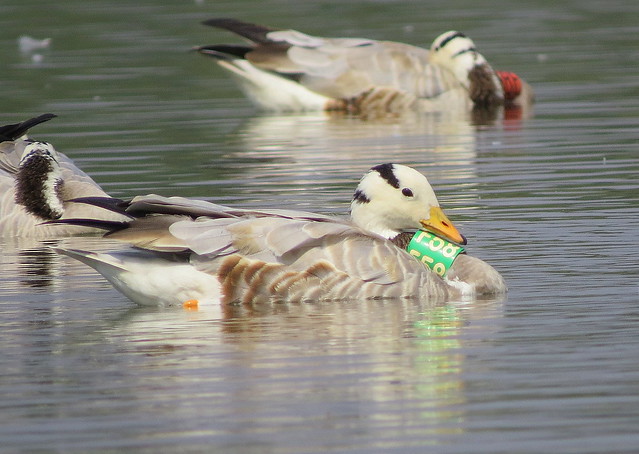
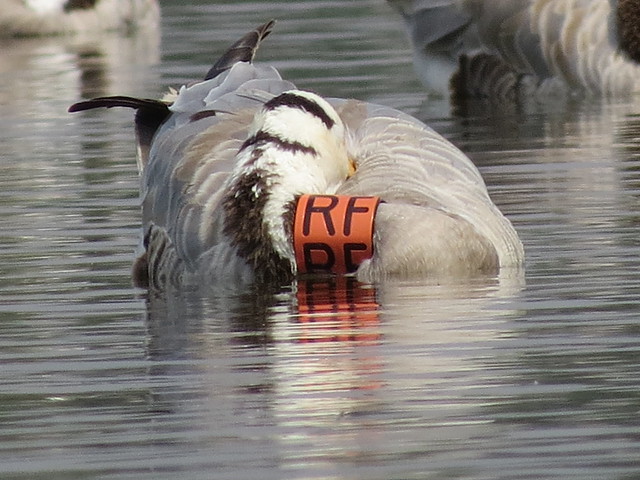 I am hoping to get some knowledge about this.
I don't have anything to show the birds flying high...but here are three videos of the birds landing, arriving from the fields across to the water on the Hadinaru kere (lake) in the Nanjangud area of Karnataka.
I am hoping to get some knowledge about this.
I don't have anything to show the birds flying high...but here are three videos of the birds landing, arriving from the fields across to the water on the Hadinaru kere (lake) in the Nanjangud area of Karnataka.
It was lovely to watch these beautiful birds in their hundreds, wintering in our shores. We saluted their stamina and strength, as we left them bobbing on the water.

